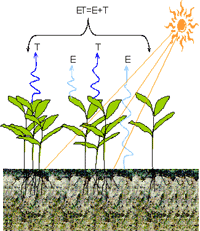Agricultural Research Division of IANR

West Central Research and Extension Center, North Platte
Date of this Version
8-2020
Citation
Irrigation Science (2020) 38:519–534
doi:10.1007/s00271-020-00683-2
Abstract
Crop nitrogen (N) status is known to affect crop water status and crop water use. To investigate further the N effects on soil water changes and on canopy temperature, three water levels × four N levels were imposed on two growing seasons of maize in west central Nebraska, USA. Soil water changes were measured using a neutron probe, whereas canopy temperature was measured using infrared thermometers on a ground-based mobile platform. At all water levels, soil water losses over monthlong intervals were generally greater as N levels increased. Given equal water levels, early afternoon canopy temperatures were usually lower with higher N levels, but no trend or even the opposite trend was occasionally observed. Jointly considering canopy reflectance and soil water depletion shows potential to explain much of the variation in estimated instantaneous water use among plots. However, determining the relative contributions of the canopy and soil factors on a particular day may require season-to-date knowledge of the crop. Further research on assimilating such sensor data for a combined stress coefficient would improve crop modeling and irrigation scheduling when variable water sufficiency and variable N sufficiency are simultaneously significant.
Included in
Agriculture Commons, Bioresource and Agricultural Engineering Commons, Ecology and Evolutionary Biology Commons, Hydraulic Engineering Commons, Plant Sciences Commons, Water Resource Management Commons


Comments
US government work